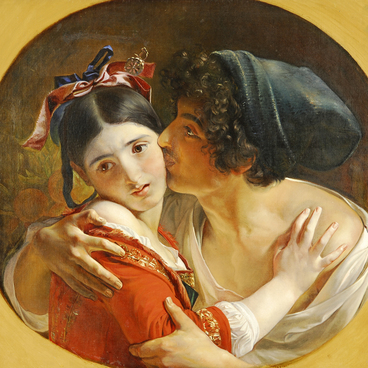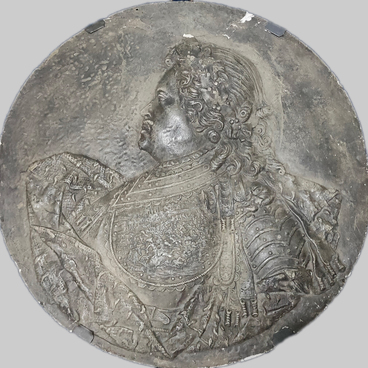The Portrait of Count Stroganov was created by an unknown artist in the middle of the 18th century. The artist created a commemorative portrait of a member from the noble family of the Stroganovs. The artist portrayed the nobleman with all the characteristics of a man in his stature.
On the hero’s chest is a ribbon with the order of St. George written on it. This distinction stands out from other distinctions as it rewarded personal bravery on the battlefield. On his statute it says: “Neither coming from nobility, nor getting injured in battle by the enemy would make you eligible to receive such an award: The honor is given to those who not only served their positions well and have done everything according to their pledges, integrity and duty, but also those that have distinguished themselves by performing an especially courageous act… .” Additionally, with great honor, the hero in the portrait displays the star of the order of St. Anne for his services in the field of public service. Unlike other Russian distinctions, this one is worn on the right side of the chest, and not on the left. The blonde wig and lace frill also speak of the distinguished nobleman.
The artist portrayed Count Stroganov in a dark kaftan with red cuffs and gold embroidery. In terms of cut and color, the nobleman’s outfit identifies with the fashion of the second half of the 18th century. By this time, Peter I’s reforms were already in effect, and portrait art was becoming more and more popular.
The origins of Russian portrait art stems from what is called “parsuna, ” from the latin word “persona, ” meaning personality. This early form of portrait art was ubiquitous with the second half of the 17th century. A parsuna was closely associated with medieval thinking — such images strongly resembled icons. However, during the time of the “great metamorphosis, ” (which is what contemporaries called the era of Peter I) new Russian art emerged. Eventually, the paintings ceased to only display religious themes and began introducing secular related themes. Also, the style of painting changed as well, everything looked significantly more realistic. Peter I invited foreign painters to paint at his palace. At the same time, he asked them to teach Russian artists the European approach to painting.
Thus parsuna gave way to the European art style. Artists began to deviate from icon paintings, and portraits conveyed the personality of a character much more. In Russian paintings volume and accurate anatomical drawings began to become the new norm. Interest in individuality immensely grew. In the past the person was not valued for their individuality, rather more so for their public service. Authentic portraits of many prominent contemporaries emerged by the early 18th century.
These include the portrait of Count Stroganov. Stroganovs were a family of Russian industrialists and landowners, and the descendants of this family were very prominent landowners and public figures in government between the 16th and 20th centuries. From the 18th century the Stroganovs became the barons and counts of the Russian Empire. The male lineage lasted until 1923.
On the hero’s chest is a ribbon with the order of St. George written on it. This distinction stands out from other distinctions as it rewarded personal bravery on the battlefield. On his statute it says: “Neither coming from nobility, nor getting injured in battle by the enemy would make you eligible to receive such an award: The honor is given to those who not only served their positions well and have done everything according to their pledges, integrity and duty, but also those that have distinguished themselves by performing an especially courageous act… .” Additionally, with great honor, the hero in the portrait displays the star of the order of St. Anne for his services in the field of public service. Unlike other Russian distinctions, this one is worn on the right side of the chest, and not on the left. The blonde wig and lace frill also speak of the distinguished nobleman.
The artist portrayed Count Stroganov in a dark kaftan with red cuffs and gold embroidery. In terms of cut and color, the nobleman’s outfit identifies with the fashion of the second half of the 18th century. By this time, Peter I’s reforms were already in effect, and portrait art was becoming more and more popular.
The origins of Russian portrait art stems from what is called “parsuna, ” from the latin word “persona, ” meaning personality. This early form of portrait art was ubiquitous with the second half of the 17th century. A parsuna was closely associated with medieval thinking — such images strongly resembled icons. However, during the time of the “great metamorphosis, ” (which is what contemporaries called the era of Peter I) new Russian art emerged. Eventually, the paintings ceased to only display religious themes and began introducing secular related themes. Also, the style of painting changed as well, everything looked significantly more realistic. Peter I invited foreign painters to paint at his palace. At the same time, he asked them to teach Russian artists the European approach to painting.
Thus parsuna gave way to the European art style. Artists began to deviate from icon paintings, and portraits conveyed the personality of a character much more. In Russian paintings volume and accurate anatomical drawings began to become the new norm. Interest in individuality immensely grew. In the past the person was not valued for their individuality, rather more so for their public service. Authentic portraits of many prominent contemporaries emerged by the early 18th century.
These include the portrait of Count Stroganov. Stroganovs were a family of Russian industrialists and landowners, and the descendants of this family were very prominent landowners and public figures in government between the 16th and 20th centuries. From the 18th century the Stroganovs became the barons and counts of the Russian Empire. The male lineage lasted until 1923.



